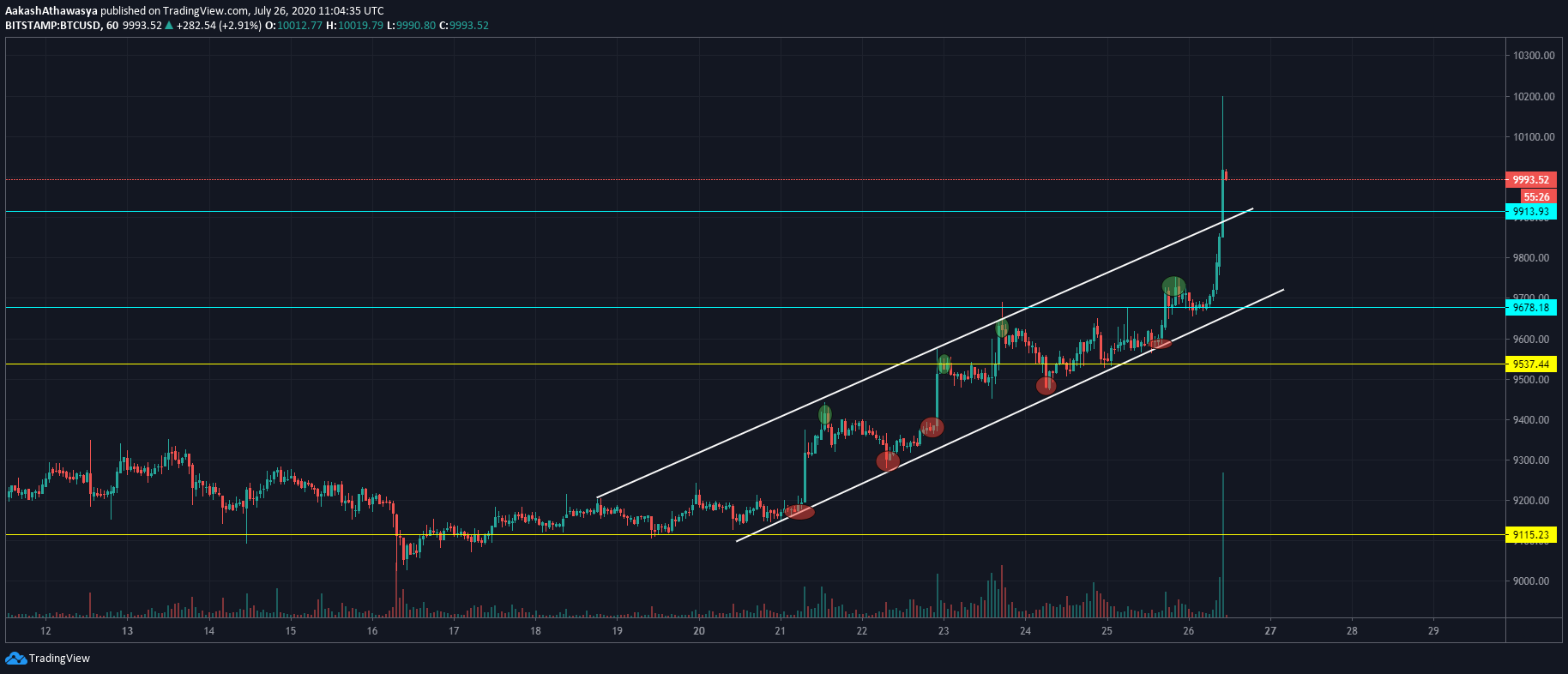Analysis
Bitcoin short-term price analysis: 26 July

Bitcoin has recently concluded one of its best trading weeks of the past three months with a move over $10,000. Since the beginning of the week, the premier cryptocurrency has seen a 6.5 percent price increase which has taken it past $9,600 and then past the five-figure mark after a month of trading in a tight channel. This move has unsurprisingly buoyed the altcoin market with several top-cryptos seeing double-digit price increases on the back of isolated momentum swings and Bitcoin’s rally.
Looking at the short-term 1-hour price chart for Bitcoin, there was a clear and strong upward channel until the push over $10,000 left it behind, which took the crypto’s price from the support of $9,100 on 20 July to as high as $10,150, before a minor decline placing the price at a press time value of $10,010. During the formation of the now-broken upward channel, the cryptocurrency saw strict higher-highs and higher lows, building a stronger foundation to reach resistance break, and forming key support levels in case of a dump.
The first low can be marked at $9,150 where the lower bound of the channel begins and the successive higher-lows can be placed at $9,280, $9,360, $9,450, and $9,600 respectively. Similar to the lows, higher highs were interspersed between the lows at $9,400, the first pump on 21 July, $9,530, breaking out of the resistance at $9,500, $9,610, $9,750 and at 1000 UTC on 26 July, the price marked its highest high since it hit $9,600 on June 10, by surging past $10,000 leaving the upward channel in its wake.

Source: BTCUSD via Trading View
Regardless of this $9,500+ price holding, the breakout was important for the Bitcoin market. Prior to the first pump on 21 July, Bitcoin’s 30-day realized volatility was trending at 23 percent, which was its lowest point since March 2019 when the price was locked in the $4,000 – $4,500 range for over two months before a breakout, which eventually took it to $13,800 by the end of Q2 2019. Since 2013, Bitcoin’s 30-day realized volatility has been lower than 29 percent only 10 percent of the time. Hence, even if this push does not hold the cryptocurrency’s price over $10,000, it is still significant in pulling Bitcoin out of a low-volatility rut and back in contention with other macroeconomic assets.
The MACD indicator for Bitcoin which has been going through a roller-coaster ride since this pump began has managed to stay above 0, and now with the move past $10,000 has surged above. On two occasions – on July 21 and July 24, when the market saw decreasing momentum, MACD and Signal line moved down towards the plane, but managed to say above and saw a big-move up on 25 July, as Bitcoin jumped from $9,550 to $9,700. Now, with the price push, the MACD has distanced itself from the Signal line on the 1-hour chart.
As mentioned earlier, volatility is key for the Bitcoin market regardless of the breakout above $10,000. That being said, the breakage of such a strong upward channel shows that either this move was not organic, or it was and this final push over $10,000 was just the straw that broke the camel’s back. With the move above $10,000, the 24-hour BTC global trade volume is over $20 billion, which has been building up from a low of $12 billion a week ago and will no doubt increase as the price play in and out with the $10,000 mark. If a move down does manifest, the channel should hold strong and the aforementioned higher lows will act as strong support levels, testing the price with each dump, if at all.

